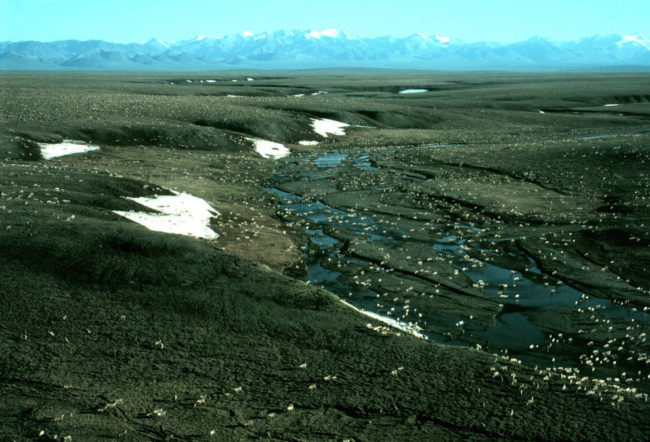
The coastal plain of the Arctic National Wildlife Refuge ranks as one of the most controversial chunks of land in Alaska. Since Congress set it aside for more study in 1980, environmental groups, politicians and industry have battled over whether to explore for oil there or to protect the wilderness forever.
As the Trump administration gets ready to take the White House in January, the debate will likely flare up again. And even though the fight has dragged on for decades, there’s still a lot we don’t know about what lies beneath the refuge.
It might be the biggest secret in Alaska:
“It’s sort of like a murder mystery — you know — a paperback book,” said David Houseknecht with the U.S. Geological Survey in Reston, Virginia. “You can speculate about why the information is not leaked out, what was found.”
Houseknecht is talking about a single exploratory oil well from 1985 — the only well ever drilled in the Arctic National Wildlife Refuge. The companies behind it, Chevron and BP, keep the results under lock and key. Even the USGS couldn’t see the data in 1998, which is when it made the most recent estimate of the amount of oil in the refuge.
Alaska’s politicians have pushed to explore for oil in the coastal plain — or 1002 area — for decades. In 1980, Congress put off permanently protecting the area like the rest of the refuge because of its potentially massive oil and gas reserves. But how much oil is actually there is a big question.
“There is a lot of uncertainty about whether or not the resources are present and whether or not the resources are of sufficient size to be deemed technically recoverable,” Houseknecht said.
USGS estimates there’s somewhere between 4.3 billion and 11.8 billion barrels of oil in the coastal plain. Those are huge numbers. For comparison, Alaska’s second biggest oil field, Kuparuk, holds about 2.5 billion barrels. So there could be an oil bonanza in the coastal plain — or not.
Whether it makes economic sense to drill there depends a lot on how big the oil deposits are and how hard it is to get to those deposits.
Some Alaskans say that uncertainty is an argument for exploration.
“We believe there is tremendous opportunity in the 1002 area,” said Andy Mack, who leads Alaska’s Department of Natural Resources.
“At a minimum, and this has always been the state’s request, is that we be able to go in and look and find out what’s there,” Mack said.
In 2014, Alaska sued the Obama administration when it refused to let the state study the coastal plain’s oil potential. Alaska’s politicians are hoping a Trump administration will finally let them find out if a huge oil discovery lies beneath the refuge.
But they’ll still face stiff opposition.
“This is a place where the Wilderness Society and others will continue to draw a line in the sand,” said Nicole Whittington-Evans of the Wilderness Society in Anchorage.
Her group believes the coastal plain isn’t just an important part of the Arctic National Wildlife Refuge — it’s the most important part of the refuge.
The state and the oil industry argue that oil development there can be done responsibly.
“No one is better equipped to drill safely in Alaska’s Arctic better than Alaskans,” Kara Moriarty, president and CEO of the Alaska Oil and Gas Association, said in a statement when the Obama administration moved to designate the coastal plain as a wilderness last year. “We’ve proved over the course of decades that Arctic oil can be produced safely and responsibly for the benefit of all Alaskans.”
But Whittington-Evans said she isn’t convinced.
“There is no way that oil and gas development could proceed in the coastal plain of the refuge without large, far-reaching infrastructure impacts across either entire sections or the entire coastal plain itself,” Whittington-Evans said.
The region is home to polar bears, migratory birds and the famous Porcupine caribou herd. The Gwich’in people have joined environmental groups in calling for the coastal plain to be protected permanently because they hunt the caribou.
“Many times people were hungry, but caribou migrate through our country,” said Sarah James, who is from Arctic Village and sits on the Gwich’in steering committee.
“If it wasn’t for the caribou, we probably wouldn’t be here today.”
But the Arctic Slope Regional Corporation is in favor of opening the coastal plain to oil exploration; the Native corporation owns subsurface rights to the spot where the mysterious test well was drilled in 1985.
And about that well: Houseknecht said the USGS wasn’t allowed to look at the results, but they could access other data collected around the test well. That means the federal government has a rough idea of what the oil companies found. But it turns out USGS has never published that finding, so the results of that test well will remain a mystery.
It will take an act of Congress to allow more oil exploration in the refuge — and Alaska’s representatives in Washington have been trying to clear that hurdle for 30 years.
Next week, reporter Liz Ruskin examines the debate ahead in Washington, D.C.